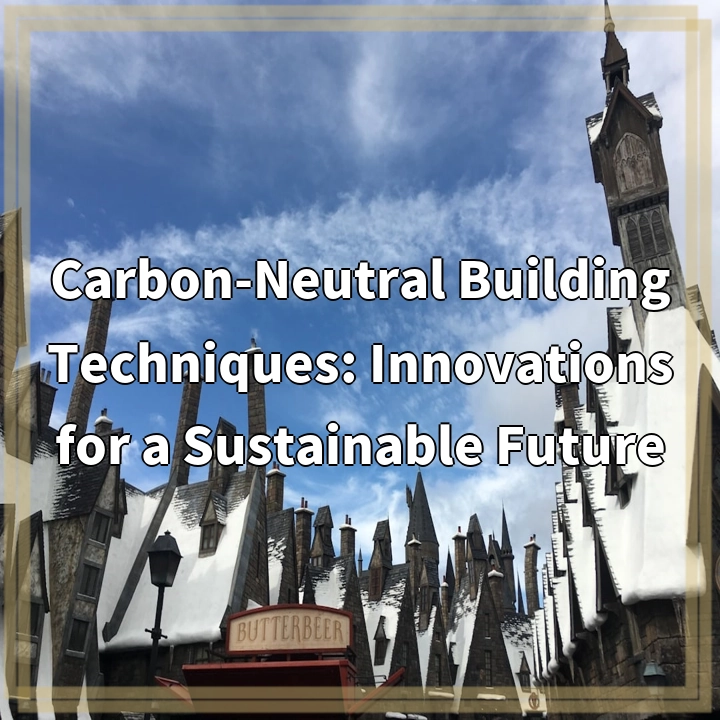
What It Is
Carbon-neutral building techniques encompass a range of architectural practices and engineering methods aimed at reducing the carbon footprint of structures. These techniques strive to balance the carbon emissions produced during construction and the building’s lifetime by either utilizing renewable energy sources or implementing energy-efficient designs. Key elements of carbon-neutral buildings include sustainable materials, energy-efficient appliances, renewable energy generation (such as solar panels), and intelligent building systems that optimize energy usage.
Core Components of Carbon-Neutral Building Techniques
1. **Sustainable Materials**: Utilizing locally sourced materials, recycled content, and low-impact resources minimizes the environmental impact during construction.
2. **Energy Efficiency**: Incorporating insulation, energy-efficient windows, and HVAC systems reduces the energy required to heat and cool a building.
3. **Renewable Energy**: Installing solar panels, wind turbines, or geothermal systems allows buildings to produce their electricity, helping to offset their energy use.
4. **Smart Technology**: Implementing building management systems can monitor and optimize energy consumption in real-time.
Real-World Problems
Despite the promise of carbon-neutral building techniques, several real-world problems hinder widespread adoption:
1. High Initial Costs
The upfront investment for sustainable materials, advanced technologies, and renewable energy systems can be significantly higher than traditional construction methods. This financial barrier often discourages property developers and homeowners from pursuing carbon-neutral projects.
2. Lack of Awareness and Expertise
Many architects, builders, and contractors may lack the knowledge or training required to implement innovative carbon-neutral techniques. This skills gap can lead to suboptimal designs and ultimately hinder the effectiveness of carbon-neutral buildings.
3. Regulatory Challenges
Building codes and regulations may not always support or incentivize carbon-neutral construction. In some regions, outdated policies can create obstacles for implementing the latest sustainable techniques.
4. Limited Availability of Materials
Access to sustainable materials can be limited, particularly in regions with less developed supply chains. This scarcity may lead to longer construction times or reliance on less sustainable options.
5. Performance Monitoring and Maintenance
Maintaining the efficiency of carbon-neutral buildings over time requires ongoing monitoring and maintenance. Property owners may neglect these responsibilities, resulting in decreased energy efficiency and increased emissions.

Solutions to Carbon-Neutral Building Challenges
To address the challenges faced by carbon-neutral building techniques, a multi-faceted approach is essential. By focusing on education, policy reform, and financial incentives, stakeholders can work towards a sustainable future in the construction industry.
1. Financial Incentives and Funding Options
Governments and financial institutions can provide grants, tax credits, and low-interest loans to encourage property developers and homeowners to invest in carbon-neutral building techniques. This financial support can help offset the initial costs associated with sustainable construction.
2. Education and Training
Enhancing the education and training of architects, builders, and contractors is crucial. Offering workshops, certifications, and continuing education programs focused on carbon-neutral techniques can bridge the skills gap and promote best practices.
3. Policy Support and Regulations
Updating building codes and regulations to incentivize carbon-neutral construction is essential. Policymakers can create frameworks that promote sustainable practices, including streamlined permitting processes for eco-friendly projects.
4. Supply Chain Development
Investing in the development of a robust supply chain for sustainable materials can increase their availability. Collaboration between manufacturers, suppliers, and construction firms will help reduce reliance on traditional, high-impact resources.
5. Ongoing Monitoring and Maintenance Programs
Establishing programs for monitoring and maintaining carbon-neutral buildings can ensure they remain efficient throughout their lifespan. Property owners should be encouraged to engage in regular assessments and updates to keep their systems optimized.
6. Community Engagement and Awareness Campaigns
Increasing public awareness about the benefits of carbon-neutral buildings can stimulate demand. Community engagement initiatives, demonstrations, and educational campaigns can inspire individuals and businesses to consider sustainable construction options.















